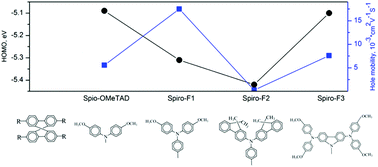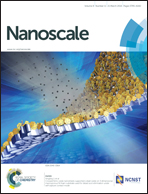Exploring the electrochemical properties of hole transport materials with spiro-cores for efficient perovskite solar cells from first-principles†
Abstract
Perovskite solar cells (PSCs) with organic small molecules as hole transport materials (HTMs) have attracted considerable attention due to their power conversion efficiencies as high as 20%. In the present work, three new spiro-type hole transport materials with spiro-cores, i.e. Spiro-F1, Spiro-F2 and Spiro-F3, are investigated by using density functional theory combined with the Marcus theory and Einstein relation. Based on the calculated and experimental highest occupied molecular orbital (HOMO) levels of 30 reference molecules, an empirical equation, which can predict the HOMO levels of hole transport materials accurately, is proposed. Moreover, a simplified method, in which the hole transport pathways are simplified to be one-dimensional, is presented and adopted to qualitatively compare the molecular hole mobilities. The calculated results show that the perovskite solar cells with the new hole transport materials can have higher open-circuit voltages due to the lower HOMO levels of Spiro-F1 (−5.31 eV), Spiro-F2 (−5.42 eV) and Spiro-F3 (−5.10 eV) compared with that of Spiro-OMeTAD (−5.09 eV). Furthermore, the hole mobilities of Spiro-F1 (1.75 × 10−2 cm2 V−1 s−1) and Spiro-F3 (7.59 × 10−3 cm2 V−1 s−1) are 3.1 and 1.4 times that of Spiro-OMeTAD (5.65 × 10−3 cm2 V−1 s−1) respectively, due to small reorganization energies and large transfer integrals. Interestingly, the stability properties of Spiro-F1 and Spiro-F2 are shown to be comparable to that of Spiro-OMeTAD, and the dimers of Spiro-F2 and Spiro-F3 possess better stability than that of Spiro-OMeTAD. Taking into consideration the appropriate HOMO level, improved hole mobility and enhanced stability, Spiro-F1 and Spiro-F3 may become the most promising alternatives to Spiro-OMeTAD. The present work offers a new design strategy and reliable calculation methods towards the development of excellent organic small molecules as HTMs for highly efficient and stable PSCs.


 Please wait while we load your content...
Please wait while we load your content...